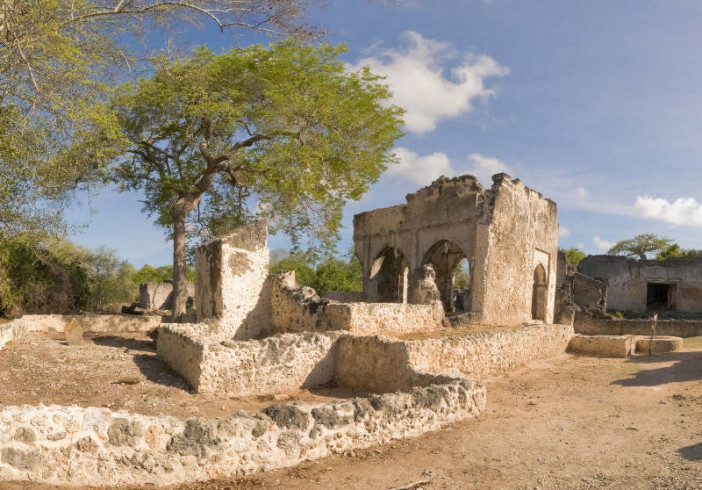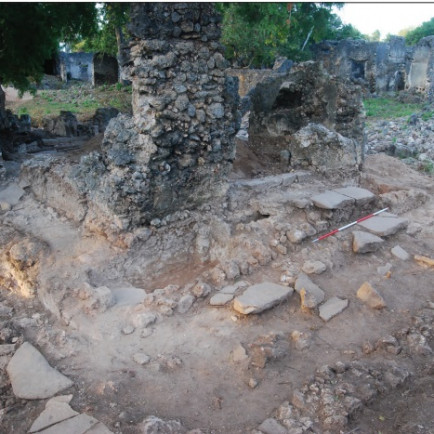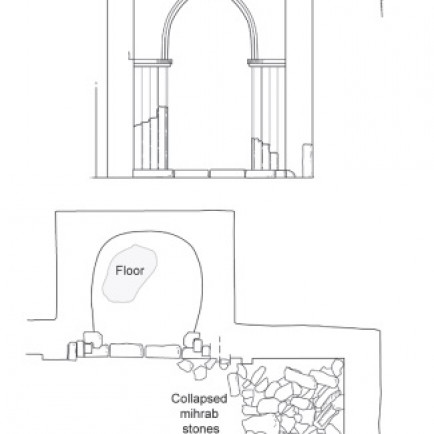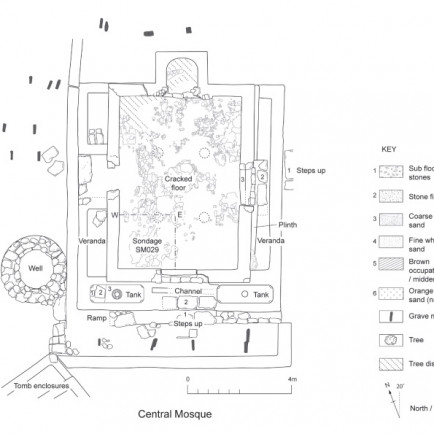Songo Mnara Central Mosque
History
The Central mosque is located in the central area of Songo Mnara Site, dating back to the 15th century. Due to its prominent location on the property, it might be the first and original mosque. If there was a wooden minbar nearby, the pattern of the floor wear to the right of the mihrab might indicate that it was the Friday mosque.
Urban and Architectural
The rectangular (6.72 x 4.66-4.75 m) prayer hall had a flat brick roof supported by four circular wooden columns built into the floor on substantial stone foundations below the floor, and it had a qibla line of 004 degrees. On the south, east, and west sides of the mosque, there were three doorways. Three shaped sandstone steps on the flanks (which were likely arched) lead to open side verandas.
The mihrab had four jamb orders and was remarkably flat and concave. The higher portions that were built from the blocks included a capital with double herringbone decoration and a two-order arch with a double apex nick, all of which were encircled by a plain architrave.
Description
The mosque's washing room was initially freestanding, but during the course of its existence, some additional walls were built. An enclosure wall was constructed there, and the area was utilized for burials to the south of this washing area. This wall's proximity to a destroyed tomb—which itself had bordered an earlier tomb—indicates that it was an addition made later in the series. More graves were surrounded on the north side by a low cemetery wall, which was abutted by a western plinth that was also constructed.
References
https://en.wikipedia.org/wiki/Songo_Mnara
https://www.zamaniproject.org/site-tanzania-songo-mnara.html
Details
Location
Ruins of Songo Mnara UNESCO World Heritage SIte, Songa Mnara Island, Tanzania
Worshippers
80
Year of Build
15th Centurey
Area
120
Drawings
Map
History
The Central mosque is located in the central area of Songo Mnara Site, dating back to the 15th century. Due to its prominent location on the property, it might be the first and original mosque. If there was a wooden minbar nearby, the pattern of the floor wear to the right of the mihrab might indicate that it was the Friday mosque.
Urban and Architectural
The rectangular (6.72 x 4.66-4.75 m) prayer hall had a flat brick roof supported by four circular wooden columns built into the floor on substantial stone foundations below the floor, and it had a qibla line of 004 degrees. On the south, east, and west sides of the mosque, there were three doorways. Three shaped sandstone steps on the flanks (which were likely arched) lead to open side verandas.
The mihrab had four jamb orders and was remarkably flat and concave. The higher portions that were built from the blocks included a capital with double herringbone decoration and a two-order arch with a double apex nick, all of which were encircled by a plain architrave.
Description
The mosque's washing room was initially freestanding, but during the course of its existence, some additional walls were built. An enclosure wall was constructed there, and the area was utilized for burials to the south of this washing area. This wall's proximity to a destroyed tomb—which itself had bordered an earlier tomb—indicates that it was an addition made later in the series. More graves were surrounded on the north side by a low cemetery wall, which was abutted by a western plinth that was also constructed.







